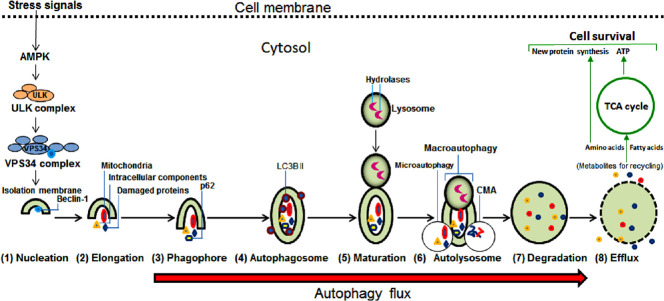Figure 1.
Sequential steps in induction of autophagy.
The extracellular stress signals such as nutrient deficiency, hypoxia, and injury trigger intracellular activation of adenosine 5' monophosphate-activated protein kinase (AMPK) to initiate formation of the Unc-51 like kinase (ULK) complex that in turn leads to generation of the vacuolar protein sorting 34 (VPS34) complex for bringing about the isolation membrane, which is the first step in induction of autophagy, followed by seven subsequent steps. Autolysosome, in addition to macroautophagy, may perform microautophagy and chaperone-mediated autophagy (CMA) and lead to the next step for lysosomal digestion of all cargos. Efflux, the final step of autophagy, releases the metabolites that are new building blocks (amino acids, fatty acids, nucleotides, sugars, etc.) into the cytosol for recycling. Recycling of amino acids and fatty acids via the Krebs cycle, also known as the tricarboxylic acid (TCA) cycle, in the mitochondria generates plenty of adenosine triphosphate (ATP) molecules to fuel biosynthesis of cellular macromolecules such as proteins (using amino acids), lipids (using fatty acids) and genetic materials (DNA and RNA molecules using nucleotides and sugars) to support and sustain cell survival.

